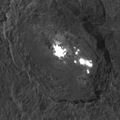Occator
Coordinates: 19 ° 51 ′ 36 ″ N , 120 ° 40 ′ 12 ″ W.
| Ceres crater Occator | |
|---|---|
|
Image of Occator crater from the Dawn spacecraft |
|
| properties | |
| width | 19.86 N |
| length | 239.33 O |
| diameter | 92 km |
| depth | 4 km |
| Namesake | Occator, helper of the Roman goddess Ceres |
Occator is an impact crater on the dwarf planet Ceres . It has a diameter of 92 kilometers and is one of the most prominent structures on Ceres with several striking bright spots.
The crater was named after the Roman deity Occator, the god of the harrow , who was a helper to the goddess Ceres . The name was officially confirmed by the IAU on July 3, 2015.
description
Occator is the 16th-largest named crater on Ceres. It is located in the equatorial plateau Hanami Planum, at the 20th parallel north.
The walls of the crater rise 25 percent from the inside almost vertically and reach heights of almost 2000 meters. Right next to such steep places there are parts that are marked by large landslides . The immediate vicinity of such extremes of stability and instability could indicate differences in material or strength.
The center of the crater forms a depression about eleven kilometers in diameter, in the middle of which there is a light, dome-shaped dome about three kilometers wide and about 400 meters high. The dome is riddled with cracks and apparently consists of certain salts that were extracted by cryovolcanic eruption processes as a result of the impact that formed the crater .
Light structures
The conspicuous bright structures of the crater have already been found by comparatively low-resolution terrestrial observations at the Keck Observatory on Mauna Kea and are provisionally designated as "Region A". Only through the Dawn space probe could the associated crater be identified and the structure of these spots clarified. The central spot was named Cerealia Facula ("Torch of the Ceres Festival") in 2016 , it is the brightest area of the entire dwarf planet. The eastern group of spots was named Vinalia Faculae ("Torches of the Wine Festival").
The first observations by Dawn from a greater distance led some scientists to assume a kind of ground fog at the bottom of the crater. On December 9, 2015, scientists reported that the bright spots may have got their color from salts derived from a type of brine containing magnesium sulfate or from clays containing ammonium . A June 29, 2016 report puts the age of the craters at 80 million years ago and attributes the white spots to sodium carbonate and some more recent form of hydrothermal activity triggered by meteorite impact. In addition, the signatures of ammonium chloride and / or ammonium bicarbonate were recognized.
A publication from March 8, 2017 dated Cerealia Facula to an age of 4 million years and 30 million years younger than the impact crater; the material referred to a previously unknown form of carbonate. The Vinalia Faculae therefore consist of a mixture of carbonates and darker material.
Facula, in the plural Faculae, derived from the German term torch , is the Latin generic name for bright spots in the planetary nomenclature . The crater is the namesake of the cartographic Occator Hemisphere of Ceres, the side piece to the Kerwan Hemisphere.
gallery
Animation: Flight over Occator
Web links
Individual evidence
- ↑ a b Planetary Names: Crater, craters: Occator on Ceres. Retrieved April 1, 2017 (English).
- ↑ Planetary Names: Ceres. (No longer available online.) Archived from the original on October 13, 2017 ; accessed on May 21, 2017 (English). Info: The archive link was inserted automatically and has not yet been checked. Please check the original and archive link according to the instructions and then remove this notice.
- ↑ DLR : Ceres: crater walls steeper than the north face of the Eiger. September 9, 2015, accessed May 21, 2017 .
- ↑ MPS : Cryovolcanism on the dwarf planet Ceres. March 6, 2017. Retrieved May 25, 2017 .
- ↑ Planetary Names: Facula, faculae: Cerealia Facula on Ceres. Retrieved April 1, 2017 (English).
- ↑ Planetary Names: Facula, faculae: Vinalia Faculae on Ceres. Retrieved April 1, 2017 (English).
- ↑ Thomas Roatsch: Ceres Nomenclature. (PDF) NASA / JPL-Caltech / UCLA / MPS / DLR / IDA, February 28, 2017, accessed on April 1, 2017 .
- ↑ New Clues to Ceres' Bright Spots and Origins. Retrieved April 1, 2017 (English).
- ↑ Tony Greicius: Recent Hydrothermal Activity May Explain Ceres' Brightest Area . In: NASA . June 28, 2016 ( nasa.gov [accessed April 1, 2017]).
- ↑ Tony Greicius: Dawn Identifies Age of Ceres' Brightest Area . In: NASA . March 7, 2017 ( nasa.gov [accessed April 1, 2017]).
- ^ Tilmann Althaus: The first atlas of Ceres is finished. November 26, 2015, accessed May 26, 2017 .












